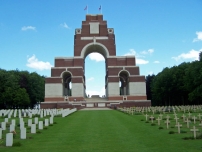| First Name: | Bernard Charles | Last Name: | WHITE | |
|---|---|---|---|---|
| Date of Death: | 01/07/1916 | Lived/Born In: | Pinner | |
| Rank: | Lieutenant | Unit: | Northumberland Fusiliers20 | |
| Memorial Site: | Thiepval Memorial, France | |||
Current Information:Age-29 15, West End Avenue, Pinner
The opening day of the Battle of the Somme 1st July 1916 This was a disastrous day for the British Army in France. Eleven divisions of Fourth Army attacked along a fifteen mile front from Maricourt to Serre. Two further divisions of Third Army launched a diversionary attack just to the north of Serre at Gommecourt. For a week beforehand the British artillery pounded the German trenches but the Germans had been there for a long time and they had constructed deep, concrete reinforced shelters beneath their trenches and many survived the bombardment. The troops went over the top at 7.30 am but even before they had left their overcrowded trenches, many had been killed or maimed by German artillery. The Germans knew that they were coming. Once in No-Man’s-Land the artillery continued to take its toll and then the machine guns opened up on the advancing British infantry. They fell in their thousands and the attack came to a standstill almost everywhere. Survivors sought cover wherever they could find it and at night they crawled back to their own lines, often dragging a wounded soldier with them. Only in the south were any advances made with the attack on Fricourt and Mametz. Over 19,000 British soldiers were killed on this day, including 2,500 from London. On 1st July, 34th Division attacked either side of La Boiselle. Two large mines, ’Lochnager’ & ‘Y Sap’ were fired two minutes before zero and all twelve infantry battalions were used in the first assault in successive waves. They attacked in four columns, each column three battalions deep and on a frontage of 400 yards. La Boiselle was not to be attacked directly, but cleared by bombers from both flanks, so there was a gap between the third and fourth columns. It was presumed that the bombardment would have ‘wiped out’ the German defenders and the two mines would destroy the flanking shoulders of the salient there. But the first wave met well placed German machine guns and within ten minutes had 80% casualties. They made easy targets as they advanced across the 200-800 yards wide no-man’s land down the front slopes of the Tara-Usna ridge. 20th Northumberland Fusiliers and 23rd Northumberland Fusiliers (1st & 4th Tyneside Scottish) of 102 Brigade led the fourth column with 25th Northumberland Fusiliers (2nd Tynside Irish) following. They followed the contour of Mash valley and had 800 yards of no-man’s land to cross. The advance depended on the bombardment wiping out of the defences of the two villages which of course it did not and as a result 20th Northumberland Fusiliers and 23rd Northumberland Fusiliers were practically annihilated before they reached the German line with 25th Northumberland Fusiliers losing heavily too. One of the many casualties suffered by 20th Northumberland Fusiliers was Bernard White who was killed. |
||||
| « Back to Search Results | ||||
| If you think any of the information shown here is incorrect, Click Here to submit your amends and comments | ||||




